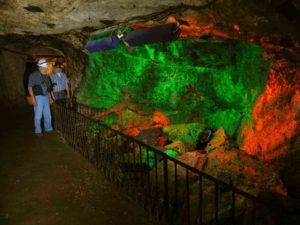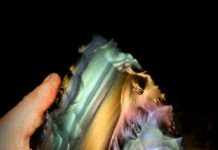
In a New Jersey mine spanning 2,670 vertical feet—more than twice as deep as the Empire State Building is tall—visitors might notice a little glow. The Sterling Hill Mining Museum is well known to have the largest collection of fluorescent rocks publicly exhibited in the world— one that shines bright neon colors under certain types of light.
The museum is an old zinc mine— one of the country’s oldest, opened in 1739 and in operation until 1986, when it was an important site for zinc removal, as well as iron and manganese removal. The abandoned mine was bought in 1989 and turned into a museum in 1990, and now attracts about 40,000 visitors each year. The museum itself includes both outdoor and indoor mining exhibits, rock and fossil discovery centers, an observatory, an underground mine tour and the Thomas S. Warren Museum of Fluorescence, devoted to the glowing minerals.
The Museum of Fluorescence occupies the old mill of the mine, a building dating back to 1916. There are approximately 1,800 square feet of rooms, with more than two dozen exhibits— some of which you can view and experience alone. Even the entrance is impressive; over 100 large fluorescent mineral specimens cover a whole wall that is illuminated by various types of ultraviolet light, showing the sparkling capabilities of each mineral type. For kids, there’s a “cave,” complete with a fluorescent volcano, a castle and some glowing wildlife. And there’s an exhibit comprised solely of fluorescent rocks and minerals from Greenland. All told, more than 700 objects are on display in the museum.
Approximately 15 percent of minerals fluoresce under black light and usually do not glow during the day. Essentially, ultraviolet light reflecting on these minerals is absorbed into the rock, where it interacts with the material’s chemicals and excites the mineral’s electrons, releasing its energy as an outward glow. Different types of ultraviolet light— longwave and shortwave — can produce different colors from the same rock, and some rocks can glow multiple colors that have other materials within them (called activators).
“A mineral could pick up different activators depending on where it is made, so a specimen from Mexico could fluoresce a different color than one from Arizona, even though it’s the same mineral,” Jill Pasteris, a professor of earth and planetary sciences at Washington University, told the newspaper at the college. “A few rocks, on the other hand, are just fine fluorescents. Of example, calcite will shine in just about any fluorescent colour. Yet interestingly enough, having too much of an activator can also prevent fluorescence. So an excess of a generic activator such as manganese will keep from lighting up a good fluorescer like calcite.
Among the most exciting aspects of the Sterling Hill mine tour is the walk through the Rainbow Tunnel culminating in a whole fluoresced room called the Rainbow Room. Much of the route is illuminated by ultraviolet light which causes the exposed zinc ore in the walls to burst with flashing, neon reds and greens. The green color stands for another form of zinc ore called willemite. The color of the mineral can vary wildly at daylight — all from the usual reddish-brown pieces to crystallized and gem-like blues and greens — but all variations fluoresce bright neon green. When the mine was active, the ore covered the walls throughout, so anyone shining ultraviolet light would have had a similar experience to what occurs in the tunnel today.










